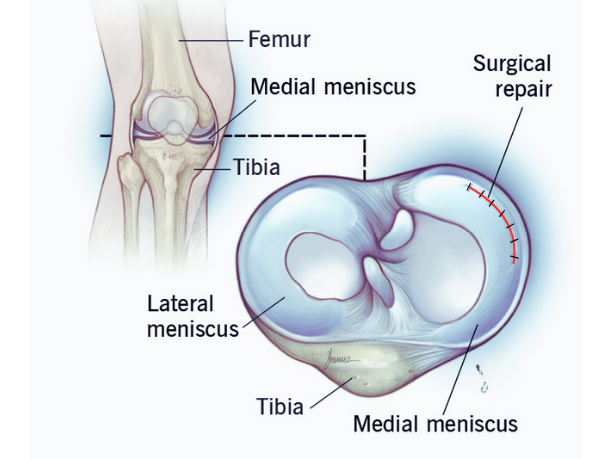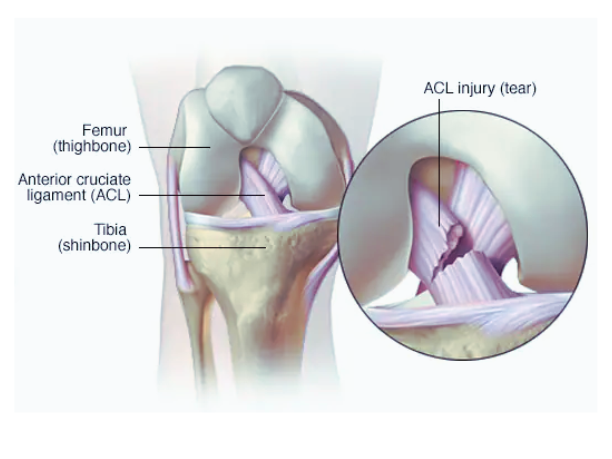What Is Knee Arthroscopy?
Knee arthroscopy is a widely used surgical procedure that aims to reduce patient recovery time and pain compared to traditional open surgery. This minimally invasive technique enables orthopedic surgeons to inspect the interior of the damaged knee joint, diagnose the injury, and perform the necessary repairs. Arthroscopic knee surgery involves the use of an arthroscope, which is a tiny camera, and specialized, thin surgical instruments to examine, diagnose, and repair the knee and its surrounding structures.
Common Knee Condition Treated by Knee Arthroscopy?
Knee arthroscopy is commonly used to treat a variety of knee conditions. Some of the most common conditions include:
Meniscus Tears:
The meniscus is a cartilage cushion in the knee that can tear due to sudden twisting movements or age-related wear and tear. Arthroscopy can be used to trim or repair the torn meniscus, relieving pain and improving knee function.


Anterior Cruciate Ligament (ACL) Injuries:
The ACL is a key ligament that helps stabilize the knee. It is often torn during high-impact sports or sudden changes in direction. Knee arthroscopy allows for ACL reconstruction, where the torn ligament is replaced with a graft.
Loose Bodies:
These are small fragments of bone or cartilage that break off and float within the knee joint, causing pain, swelling, and restricted movement. Arthroscopy can be used to locate and remove these loose bodies.
Patellar (Kneecap) Issues:
Conditions such as patellar maltracking (where the kneecap doesn’t move properly) or recurrent patellar dislocation can cause pain and instability. Arthroscopy can help realign the kneecap or address any underlying issues.
Plica Syndrome:
Plica is a fold in the synovial tissue that can become inflamed and thickened, leading to knee pain and irritation. Arthroscopy can be used to remove the inflamed plica tissue.
Revision ACL Reconstruction:
Knee arthroscopy can be used for ACL Reconstruction Revision in cases of a previously failed ACL graft. It allows surgeons to view and address complications, remove the old graft if necessary, and place a new one with precision. This minimally invasive approach offers accurate visualization, reduced pain, and faster recovery, making it an effective solution for restoring knee stability and function.
Synovitis:
Inflammation of the synovial membrane (lining of the knee joint) can occur due to conditions like rheumatoid arthritis. Arthroscopy can help reduce inflammation by removing the affected synovial tissue.
Procedure for Knee Arthroscopy
Pre-Procedure Preparation: Before undergoing knee arthroscopy, it’s important to inform your surgeon about any medications you are currently taking. Certain medications, such as blood thinners, may need to be discontinued before surgery. Your provider will also give you specific instructions on when to stop eating and drinking the night before the procedure.
Right before the procedure, anesthesia will be administered to ensure that you do not experience any pain during the surgery. Depending on your case, your surgeon may use:
- Local anesthesia to numb the specific area.
- Regional anesthesia to numb the body from the waist down.
- General anesthesia is used to induce sleep during the procedure.
During the Procedure: Once the procedure begins, clean your leg and secure your knee in a stabilizing device to ensure it stays in the correct position.
- Make a small incision in your knee and insert an arthroscope—a long, thin instrument with a camera on the end—through the incision. The camera provides live images on a monitor in the operating room.
- Examine the images to diagnose the issue and guide the procedure. If surgery is needed, additional small incisions may be made to insert specialized tools.
- Repair or remove damaged tissues, bone, or cartilage using arthroscopic tools.
- Close the incisions with stitches or small bandages, then wrap the knee with a larger bandage or dressing.
Post-Procedure Care: Knee arthroscopy is typically an outpatient procedure, allowing you to go home the same day. The procedure usually lasts about an hour, though some cases may require a hospital stay.
After the procedure, you’ll need someone to drive you home. During the initial recovery period, you may experience some pain. To aid in your recovery during the first few days, you should:
- Rest: Avoid putting weight on your knee. You may need crutches or a walker to assist with mobility.
- Elevate Your Knee: Keeping your knee elevated can help reduce swelling and relieve pain.
- Take Pain Medication: Your joint replacement specialist may recommend over-the-counter NSAIDs or prescribe pain medication. Follow their instructions carefully when taking these medications. You might also need medication to reduce swelling or prevent blood clots.
- Protect the Incisions: Keep the bandages on your knee intact and the area clean. Ask your surgeon when it’s safe to remove the dressing, take a shower, or bathe.
After you’ve recovered from the procedure, you may suggest physical therapy (PT). A personalized PT program can help restore strength and mobility. Your physical therapist will guide you through exercises designed to enhance flexibility, strengthen knee-supporting muscles, and prevent future injuries.
Why do Surgeons recommend Knee Arthroscopy?
A surgeon can suggest knee arthroscopy for several reasons:
- Diagnosing Injuries: Knee arthroscopy allows orthopedic surgeons to closely examine painful or swollen areas inside the knee. The camera used in the procedure provides detailed images of soft tissue and bone, aiding in the diagnosis of injuries and helping to confirm treatment plans.
- Repairing Soft Tissues and Bones: During the procedure, providers can use specialized instruments to repair tendons, ligaments, and cartilage. The camera provides real-time visuals that guide the provider in making precise repairs, such as stitching soft tissues together or suturing bones.
- Removing Damaged or Inflamed Tissue: Arthroscopy also enables the removal of damaged bone, cartilage, or inflamed tissue like the synovium. Providers use specific tools to shave off and remove these problematic tissues from the knee.
This minimally invasive approach helps in both diagnosing and treating knee issues with greater precision and efficiency.
Benefits of Knee Arthroscopy
Knee arthroscopy is a minimally invasive surgery that helps diagnose and treat various knee problems. Here are some key benefits:
- Less Pain: Compared to traditional surgery, knee arthroscopy usually involves less pain. The small incisions used in the procedure mean less damage to the surrounding tissues.
- Quicker Recovery: With fewer incisions and less trauma to the knee, recovery time is often faster. Most people can return to their daily activities sooner than with open surgery.
- Minimized Scarring: The small cuts made during arthroscopy result in less noticeable scarring compared to the larger cuts required in open surgery.
- Reduced Risk of Infection: Since the procedure is less invasive, there’s a lower risk of infection. The small incisions reduce exposure to bacteria and other harmful elements.
- Better Visualization: Arthroscopy provides a clear view inside the knee joint. Surgeons use a tiny camera called an arthroscope to see and address problems directly, leading to more precise treatment.
- Outpatient Procedure: In many cases, knee arthroscopy can be done on an outpatient basis. This means you can go home the same day, rather than staying overnight in the hospital.
- Less Trauma to the Joint: The procedure is designed to be gentle on the knee. This means there is less disturbance to the joint compared to more invasive surgeries.
- Improved Joint Function: By treating problems such as torn cartilage or damaged ligaments, knee arthroscopy can help improve joint function and alleviate pain, leading to better mobility and quality of life.
Frequently Asked Questions (FAQs) – Knee Arthroscopy in Nagpur
Will I be awake during the surgery?
You may be awake or asleep, depending on the type of anesthesia used. Local anesthesia numbs just the knee area, regional anesthesia numbs you from the waist down, and general anesthesia puts you to sleep during the procedure.
How long does it take to recover?
Recovery time varies depending on the specific procedure and your overall health. Most people can return to light activities within a few days, but full recovery, especially for sports or strenuous activities, may take several weeks to months. Physical therapy is often recommended to speed up recovery and improve knee function.
Will I need physical therapy after the surgery?
Yes, physical therapy is often an important part of the recovery process. It helps restore strength, flexibility, and range of motion in your knee, reducing the risk of future injuries.
How long will I be off my feet?
You’ll need to avoid putting weight on your knee for a few days after the procedure. Your doctor might recommend using crutches or a walker during this time. The duration will depend on the extent of the surgery and your individual recovery.
When can I return to work or normal activities?
This depends on the nature of your job and the extent of your surgery. Many people return to desk jobs within a week, but if your work involves heavy lifting or standing for long periods, you may need a longer recovery time. Your doctor will give you specific advice based on your situation.
Is knee arthroscopy a permanent fix?
Knee arthroscopy can effectively treat many knee problems, but its success depends on the condition being treated and how well you follow post-operative care instructions. Some conditions, like arthritis, may continue to progress even after surgery.
Why Choose Dr. Nawaid Ahmed for Shoulder Arthroscopy in Nagpur?
- Experienced orthopedic and arthroscopic surgeon
- Expertise in minimally invasive techniques
- Advanced diagnostic and surgical facilities
- Patient-centered approach with personalized care
- Proven record of successful outcomes
Dr. Nawaid Ahmed’s commitment to excellence and patient well-being makes him a trusted choice for shoulder arthroscopy in Nagpur.
Schedule Your Consultation Today
If you’re experiencing persistent shoulder pain, stiffness, or limited motion, don’t wait for the problem to worsen. Consult Dr. Nawaid Ahmed, a skilled specialist in knee arthroscopy in Nagpur, to explore safe and effective treatment options.
Contact: 9156496040, 8412918529, 9764095288